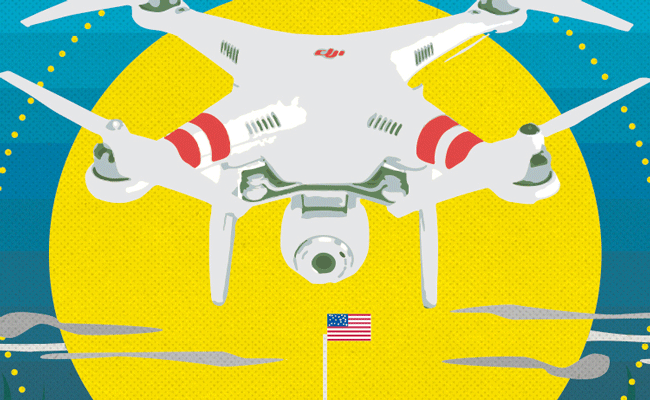
China’s DJI holds a commanding lead in the red-hot consumer drone market. Can it maintain that?
Drunken misadventures rarely spark national debate on the regulation of nascent consumer products or cast the spotlight on emerging, globally successful Chinese companies, but that was exactly what happened when a small drone crashed onto the southeast side of the White House grounds in January after its 3 am test flight went awry, in the process prompting a lockdown and igniting fears that unmanned aircraft intended for recreational purposes could pose a national security threat.
Although it turned out the drone wasn’t a threat—it was later revealed it was piloted by an inebriated off-duty government employee—the incident nonetheless vaulted a Chinese drone manufacturer and the issues surrounding consumer drones to the top of the American media agenda.
The maker of that unmanned aerial vehicle (UAV) was Dajiang Innovations (DJI), the world’s top consumer-drone company by revenue. Shenzhen-based DJI has taken drones mainstream in the consumer market over the past two years with its agile, remote-controlled quadcopters, named for the four rotors that power them.
DJI’s drones are simple to set up and priced competitively—the best-selling Phantom sells for less than $1,000—but are able to shoot professional-quality aerial footage. That positioning has made them accessible to a wide variety of users, including hobbyists, filmmakers and construction contractors, and earned DJI recognition as a rare Chinese company that is an innovator, experts say.
“DJI was the first drone maker to put together a turnkey package that doesn’t require any special knowledge to use,” says Colin Snow, CEO of Drone Analyst, a California-based UAV consultancy. “You just put on the props and go.”
The Phantom’s popularity with a broad user base has propelled DJI to the top of the burgeoning consumer-drone sector: the Shenzhen-based firm has a 70% market share, according to consultancy Frost & Sullivan.
Surging sales numbers have made DJI a darling of investors, who see rising potential in drones’ commercial use. Following a $75 million capital injection in May from VC firm Accel Partners, DJI became the world’s most valuable drone company, worth between $8 and $10 billion. The investment was the largest ever in a consumer-drone maker.
“Investors see DJI as the Amazon of drones,” says Michael Blades, a senior aerospace and defense analyst at Frost & Sullivan in Texas. “They [DJI] have strong brand recognition, which is unusual for a Chinese company.”
Learning to Fly
DJI was born from CEO Frank Wang’s interest in radio-controlled (RC) helicopters, according to company spokesperson Michael Perry. “For Frank, RC helicopters have been a life-long passion,” he says. “He wanted to devise a way to use robotics to make flying them easier.”
In 2006, after graduating from Hong Kong University of Science and Technology with a degree in electrical engineering, Wang moved to Shenzhen and founded DJI. Wang chose to base his company in Shenzhen because of its manufacturing prowess and pool of engineering talent, Perry says, adding: “Being based here is ideal. Our engineers come up with the design, send it to the factory and they send us a prototype later that day.”
At its onset, DJI initially sold Wang’s $6,000 flight controllers—a stabilizing mechanism that allows a radio-controlled helicopter to hover in place—to Chinese clients who used them on do-it-yourself (DIY) drones.
DJI soon began expanding its product offerings and selling to hobbyists in Western countries at specialized trade shows. One of its key early innovations was a transition from single-rotor designs to less expensive four-propeller quadcopters, which were simpler to program.
To sell consumer drones in the US, Wang partnered with colorful UAV entrepreneur Colin Guinn. A native of Texas, Guinn had gained minor celebrity status in the mid-2000s when he appeared on the CBS reality show The Amazing Race. Guinn led a Texas-based team in charge of marketing and distribution of DJI drones. They promoted DJI on YouTube with how-to videos featuring Guinn and created a snappy slogan for the brand—“The Future of Possible”.
Guinn was responsible for DJI’s success in the US, which now accounts for 30% of its drone sales, says Snow of Drone Analyst. “Colin Guinn was able to create a distribution network of hobby shop retailers and successfully position the brand in the nascent prosumer [a person who consumes and also becomes a brand advocate] market,” he explains. “A lot of that was his personality. He is a great promoter and a likeable guy. He also had input into the development of the Phantom which got DJI out of being solely in the maker and hobbyist realm.”
In January 2013, DJI launched the Phantom—the product that would lead to the company’s meteoric ascent. The quadcopter’s simplicity, high functionality and impressive performance in the air allowed DJI to expand the consumer drone market beyond die-hard hobbyists, analysts say.
Yet as DJI’s fortunes rose, Guinn and Wang’s relationship deteriorated. Wang believed Guinn was infringing on his authority, claiming too much credit for the development of the Phantom and taking the title of “CEO of DJI Innovations”, market insiders say. The two entrepreneurs eventually fell out, leading to the Texan’s departure from the company in late 2013. Guinn took legal action against his former employer, but they managed to settle out of court for an undisclosed sum, which is believed to be about $10 million.
When asked about Guinn’s role in DJI, DJI spokesperson Perry says the Texan was in charge of the company’s distribution and marketing channels in the US, “but it didn’t work out, so we parted ways.”
Battle for the Skies
Following his bitter split with DJI, Guinn took the money and ran to DJI’s archrival 3D Robotics, where he accepted the position of senior vice president of sales and marketing. California-based 3D Robotics, founded by former Wired magazine editor-in-chief Chris Anderson, is backed by chip-making giants Qualcomm and SanDisk and aims to take on DJI on its own turf by moving production capacity from Mexico to Shenzhen.

But Guinn’s exit has not fazed DJI, whose sales are surging. The company recorded $130 million in revenue in 2013, $500 million in 2014 and is on track to crack the $1 billion milestone this year.
“DJI is going to sell a billion dollars worth of drones this year, and that’s only a fraction of demand,” says Blades of Frost & Sullivan. “They have economies of scale and a strong first-mover’s advantage.”
DJI is pushing the drone market forward unlike any other manufacturer, says Mark Perdomo, a drone hobbyist who has built many of the devices with DIY kits. He credits DJI with popularizing the motor and prop combination most commonly used on DIY drones, developing high-voltage motors for increased efficiency, and being one of the first major drone adopters of powerful lithium power battery (LIPO) cells.
DJI has also introduced electronic speed controllers (ESCs) that use sinusoidal drive, “which is unheard of at a consumer level,” Perdomo explains. ESCs handle communication between the drone’s main controller and the motors. When equipped with sinusoidal drive, they tell each motor how fast to spin and how much power to use at all times, giving the drone user “complete control”, according to DJI.
“Most drone companies as they exist now are essentially integrators. They go out and buy commercially available parts to assemble them,” Perdomo says. “DJI is constantly researching to make these parts better, and thus will generally have access to advances first. It’s similar to how Apple is often first to get a new kind of display or battery, or first to try out a new configuration that’s different from existing norms.”
Aside from its technical strengths, “DJI flies smoother out of the box than 3D Robotics. It’s much more confidence inspiring for sure,” he adds.
Still, 3D Robotics has the potential to be a formidable challenger to DJI, analysts say. “3D Robotics is crawling up DJI’s shorts,” says Snow of Drone Analyst. “They’ve got a very strong open-source software platform they are using to positon themselves as the Android of drones.”
The 3D Robotics platform is designed to allow both individual consumers and commercial users to customize the company’s drones to their individual needs. That can include equipping the quadcopters with different cameras and sensors, software interfaces or custom apps.
For instance, when paired with action-camera maker GoPro’s cameras, 3D Robotics’ new Solo drone allows users to take challenging cinematic shots with the press of a button. Offering that type of control over drone cameras is a first in the industry, the company says. Without 3D Robotics’ software, the shots would be nearly impossible for a person to take while maintaining control of a quadcopter.
By contrast, with its built-in camera, DJI’s platform allows less room for customization, Snow says.
Not in My Airspace
For both DJI and the overall UAV sector, addressing security concerns is becoming increasingly important. Following the crash in January on the White House lawn, US President Barack Obama called for more regulation of commercial drone technology.
In an interview with CNN, Obama said the government needed to create “some sort of framework that ensures that we get the good and minimize the bad” from drones. Obama said he told federal agencies to make sure drones were not dangerous or violating people’s privacy.
Currently, the United States Federal Aviation Administration (FAA) permits drone flights for recreational purposes and generally restricts them for commercial use. But as Obama noted, the US doesn’t “really have any kind of regulatory structure at all” for the sector.
As a result, US citizens are taking the law into their own hands. On July 31, a Kentucky man, William Meredith, shot down his neighbor David Boggs’ Phantom because he thought it was spying on his children. “I had no way of knowing [if] it was a predator looking at my children,” Meredith told NBC News.
Boggs, who denies he was doing anything harmful, confronted Meredith and told him to replace the drone. At that point, Meredith told Boggs and his friends he was armed and ordered them to leave his property. Boggs called the police, who arrested Meredith and charged him with first-degree endangerment for discharging a firearm into the air.
But DJI is doing its part to make the skies safer, Perry says. He notes that the company has programmed its drones to not enter airspace over sensitive locations such as Washington, DC or airports. “The flight controllers have the GPS locations of those no-fly zones in them and so the drones won’t enter them,” he explains.
Perry is hopeful that Washington will soon relax restrictions on commercial UAV, while pointing out that DJI comprises nearly 43% of the drones that have been granted a Section 333 Exemption by the FAA to operate commercially. “The FAA wants to keep the air safe, but there is also pressure to get regulations passed soon,” he says. “There are a lot of job opportunities that will be created.”
Blades credits DJI for taking a proactive approach to security issues affecting the drone industry. “I think security is a huge concern and I think DJI has led the way with geofencing [programming UAV to not enter certain airspace] on their drones and has been, and will continue to be, ahead of competitors,” he says.
Staying One Step Ahead
DJI has had enormous success in the consumer-drone market on the back of its first-mover advantage and inexpensive but high-quality products. The company has faced few serious competitors yet, which has allowed it to grow exponentially in a short period of time. Yet DJI’s expeditious growth is likely to slow eventually, experts say.
Blades of Frost & Sullivan expects competition to intensify as new players flood into the market. “Drones are going to be a commodity at some point,” he says. “The real money in the future will be in commercial services like aerial surveying and mapping.”
To maintain its competitive edge, DJI intends to build a drone operation ecosystem, company spokesperson Perry says. “I’m not sure how fast the market will commoditize,” he says. “It’s much more complicated to develop a drone than say, a smartphone, but this ecosystem will allow our drones to be used for a wider variety of applications and expand our user base.”
In the meantime, DJI can step up expansion in Europe, says Blades. “I think Europe as a whole is an important market for DJI especially since the commercial rules for operation are generally more lenient than the US,” he says, noting that drones have been in use for commercial delivery purposes in Germany for nearly a year. In September 2014, German logistics company DHL launched a “parcelcopter service” that delivers small packages to the German island of Juist in the North Sea, home to about 2,000 people. Deliveries include medication and other “urgently needed” goods.
To gain a foothold in the burgeoning commercial drone sector, DJI rolled out a new and more powerful quadcopter called the Inspire 1 in November 2014. Targeting professional users, the Inspire boasts a 4K camera that can shoot footage with four times the picture quality of the Phantom cameras. The Inspire 1’s camera can also rotate 360 degrees while filming. The Inspire 1 sells for about $3,000, compared with roughly $1,000 for the Phantom.

The Inspire 1 is now at the forefront of expansion efforts in Latin America. In late July, Brazil’s Labor Ministry said it would use six Inspire 1 drones to monitor businesses suspected of using forced labor in Rio de Janeiro. “We’ve just started in Brazil, but there’s no doubt it’s one of the most important markets in South America due to its huge consumer base,” DJI Public Relations Director Wang Fan told Xinhua in an interview.
According to Wang, DJI’s sales in Latin America tripled year-on-year in June and July to reach “tens of millions of yuan.”
In Peru, DJI drones are being used to survey and map thousands of ancient Inca ruins sites. When the project is complete, Peru will have a national index containing more than 100,000 archeological sites. “In an effort to preserve these sites indefinitely, archaeologists work to recreate the dig sites and ancient buildings digitally using 3D mapping technology with help from DJI’s Inspire 1,” the company said in a statement.
An additional advantage for DJI is its proximity to China’s fledgling domestic drone market. In 2014, sales began growing quickly in the company’s massive home consumer market, Perry says. “Interest is picking up fast. Now you can even buy a drone in a shop at the Shenzhen airport,” he adds.
Taken together, that puts DJI in a strong position and there are clear skies ahead for the company—at least in the short term, predicts Blades of Frost & Sullivan. “It is inevitable they will lose some market share, but they are still going to dominate the market for the next few years,” he says, “So far, they have been a step ahead on everything.”
















